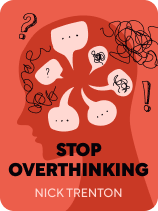

This article is an excerpt from the Shortform book guide to "Stop Overthinking" by Nick Trenton. Shortform has the world's best summaries and analyses of books you should be reading.
Like this article? Sign up for a free trial here.
What does it take to have a resilient mindset? How does resilience conquer overthinking?
In Stop Overthinking, Nick Trenton explains that, in many cases, an overthinking habit is perpetuated by negative thought patterns. To combat these patterns, you need to identify these habits, challenge them, and replace them with positive thoughts.
Let’s look at how you can create a resilient mindset that will protect you from negativity.
Conquer Overthinking With a Resilient Mindset
Negative thought patterns are unsupportive ways of thinking that hold you back rather than strengthen and empower you. Positive beliefs, on the other hand, encourage you to advocate for yourself in spite of your flaws and motivate you to move past obstacles. To manage your tendency to overthink in the long term, you must identify your negative thoughts, challenge them, and replace them with positive beliefs and a resilient mindset.
(Shortform note: According to Tony Robbins in Awaken the Giant Within, negative beliefs can be especially harmful when they’re global rather than specific. When a belief is global, you think something is always true, like that you’re awkward in every social situation. This can lead to learned helplessness, or the belief that nothing you do will change anything, which holds you back and perpetuates your negative thinking. To combat this, Robbins advises you to build powerful references that support your positive beliefs. You can do this by consuming media like books or podcasts that allow you to learn about other people’s experiences or reflect on your past positive experiences.)
Step 1: Identify Your Triggers and Negative Thinking Habits
The first step to adopting a positive mindset is to identify what triggers you to overthink. This could include anything from other people, your environment, or a specific word someone said. For example, you might spiral into doubt whenever someone says “never mind” after you ask them to repeat something.
(Shortform note: Specific people and words are personal triggers that you might develop over the course of your life. However, researchers have determined other common triggers for anxiety, such as drinking caffeine or skipping meals. To better understand your triggers, they suggest you consider consulting with a therapist, writing in a journal, or using apps to track your anxiety.)
In addition to specific triggers, you should also identify broader cognitive distortions, which are inaccurate and negative beliefs you might have about yourself and the world. These often drive anxiety and overthinking. For example, you might have a habit of taking everything personally, such as assuming you’ve done something wrong if your friend forgets to text you back.
(Shortform note: Closely tied to Trenton’s discussion of cognitive distortions and negative beliefs is the concept of self-talk, which Ethan Kross defines in Chatter as the thoughts you hear as words inside your mind. Like cognitive distortions, negative self-talk is critical and holds you back in life rather than providing support and encouragement. Trenton suggests identifying specific cognitive distortions so that you can eventually disprove and replace them. However, Kross says you can’t rid yourself of negative self-talk completely. Rather, you can learn to quiet it by seeking support from others and increasing your sense of control in life.)
To identify your triggers and cognitive distortions, Trenton suggests making a table with columns where you describe the stressful situation, how you behaved, and how you felt. For example, you might write that you had texted a friend about something you’re proud of and they never responded. Then, describe your behavior as a result of the situation: You might have neglected your chores and checked your phone every few minutes. Lastly, reflect on your feelings: Perhaps you felt anxious or unwanted as a friend.
(Shortform note: In The Success Principles, Jack Canfield offers different categories of negative thoughts that may help you in applying Trenton’s advice of identifying your cognitive distortions using a table. Common types of negative thoughts include: believing someone thinks negatively about you, fixating on the worst possible outcome, giving yourself a negative label such as “incompetent,” making the situation about you, and viewing things in extremes.)
Step 2: Challenge Your Negative Thinking Habits
To challenge your negative thought patterns, reconsider the moment through a positive lens and gather evidence to support or disprove your belief. Ask yourself whether there’s any proof for your interpretation of the situation, then write down alternative possibilities in another column of your table. To continue the above example, you might record that you later learned your friend was studying for an exam when you texted them and that you have no evidence that they’re unhappy with you.
(Shortform note: In Psycho-Cybernetics, Maxwell Maltz echoes Trenton’s suggestion to reframe your memories through a positive lens, elaborating that regularly thinking negative thoughts can lead you to make false assumptions that don’t reflect the reality of a situation. Instead, he argues that you should focus only on the facts of a situation rather than how you feel about it. To reinterpret situations more rationally, Maltz suggests you practice pausing before reacting to stressful situations and forgiving yourself for your past mistakes.)
Trenton also suggests you challenge negative thought habits by experimenting with doing the opposite of what you’re feeling. While it’s important to validate your feelings, you shouldn’t let them take control of your thoughts and actions. For example, if your anxiety makes you reluctant to go to lunch with your colleagues, try to go through with it. This way, you might find evidence that they enjoy your company, which challenges your anxiety-driven beliefs.
(Shortform note: Trenton’s suggestion of doing the opposite of what your emotions tell you to do is a technique known as opposite action in dialectical behavioral therapy. This is a type of cognitive behavioral therapy that focuses on regulating your emotions. Psychologists add that for this method to be successful, you must fully commit to the opposite action and believe that it will be successful.)
Step 3: Develop Positive Beliefs
Lastly, replace your inaccurate, negative beliefs with positive ones to become more resilient to stress and curb your overthinking. By reframing how you view yourself and the world, positive beliefs strengthen your sense of control and improve your ability to manage stressful challenges productively and effectively.
Trenton suggests you focus on three things to develop a positive mindset:
1) Be in the present moment: Focusing on the present promotes a positive worldview because it allows you to find solutions to your problems without stressing about concerns you have no control over. Instead of ruminating on periods of time you have no control over (the past and the future), you direct your attention to the resources you have now.
2) Let go of what you can’t control: Anxiety and overthinking happen when you fixate on things outside of your control. Trenton suggests you focus on what you do have control over. For example, once you’ve signed a lease for an apartment, rather than worry that you’ve chosen the wrong one, focus on ways to increase your happiness with the one you decided on. Research nearby restaurants or parks and make a plan for a smooth moving experience.
3) Identify your needs: Rather than worrying about and optimizing every little thing in your life, concentrate on meeting your needs and not your wants. Focusing solely on what you need helps you achieve a more positive mindset by allowing you to let go of unnecessary things that would otherwise drain your time and energy.

———End of Preview———
Like what you just read? Read the rest of the world's best book summary and analysis of Nick Trenton's "Stop Overthinking" at Shortform.
Here's what you'll find in our full Stop Overthinking summary:
- What overthinking is and how it’s connected to stress and anxiety
- Ways you can manage stress before, during, and after it happens
- How to conquer your habit of overthinking with long-term solutions






